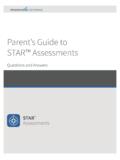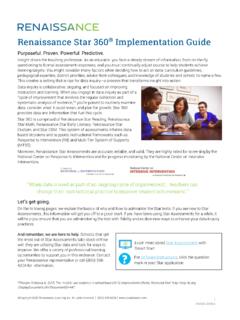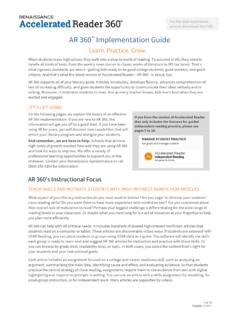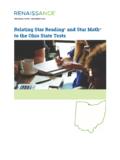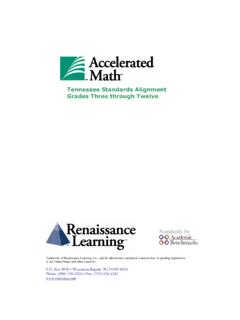Transcription of Student Growth Percentile in Star Assessments
1 SPECIAL REPORT | AUGUST 2020 Student Growth Percentile in star Assessments Copyright 2020 Renaissance Learning, Inc. All rights reserved. 2 Software visuals may vary from those shown as enhancements are made. Copyright 2020 by Renaissance Learning, Inc. All rights reserved. Printed in the United States of America. All logos, designs, and brand names for Renaissance s products and services, including but not limited to star Assessments , star Early Literacy, star Early Literacy Spanish, star Math, star Math Spanish, star Reading, star Reading Spanish, and Renaissance, are trademarks of Renaissance Learning, Inc.
2 , and its subsidiaries, registered, common law, or pending registration in the United States. All other product and company names should be considered the property of their respective companies and organizations. This publication is protected by and international copyright laws. It is unlawful to duplicate or reproduce any copyrighted material without authorization from the copyright holder. For more information, contact: RENAISSANCE Box 8036 Wisconsin Rapids, WI 54495-8036 (800) 338-4204 08/20 Copyright 2020 Renaissance Learning, Inc. All rights reserved. 3 Contents 4 Introduction 4 Growth 5 Student Growth percentiles 6 About Renaissance star Assessments 7 Applying SGP to star Assessments 10 Reporting SGPs 11 Frequently asked questions 18 References Figures 4 Figure 1.
3 Growth is better understood when performance history and peer group are considered 9 Figure 2. Official SGP score: Decision rules for score selection in the SGP model 10 Figure 3. Sample star Math Growth Report Copyright 2020 Renaissance Learning, Inc. All rights reserved. 4 Introduction Student achievement typically is gleaned from one score at a single point in time. When you consider Growth in addition to achievement, it can greatly enrich your understanding of how well a Student is performing (Betebenner, 2009; Thurlow et al., 2010). While achievement indicates whether performance is below, above, or on par with grade-level expectations, Growth explains the type of progress the Student is making over time.
4 For example, one of your students may be performing at a low level, yet experiencing high rates of Growth . Conversely, a high-performing Student s Growth could be stagnating. It is important to know how a Student is performing, but this information must have context such as, how remarkable is this Growth given a Student 's achievement history? Many state accountability systems incorporate a plan for measuring Growth over time, reflecting broad agreement that such systems must go beyond reporting the percentage of students obtaining proficiency status by the end of the school year (Domaleski & Perie, 2012). Let's examine the Student Growth Percentile (SGP) score a widely accepted indicator of Student progress used by states for purposes including instructional decisions and accountability reports that is used in the Renaissance star Reading , Renaissance star Math , Renaissance star Early Literacy , Renaissance star Reading Spanish , Renaissance star Math Spanish , and Renaissance star Early Literacy Spanish Assessments .
5 Growth Growth over time, which is sometimes called slope or rate of improvement, is of central importance in evidence-based instructional models such as Response to Intervention and Multi-Tiered Systems of Support. When you can capture and accurately interpret Growth information, you are able to make informed, data-based decisions regarding the extent to which students are benefiting from intervention or regular classroom instruction, or whether changes are warranted (Fox et al., 2009). Figure 1 illustrates why we need context to fully understand differing rates of Growth by depicting the performance of two high jumpers. Figure 1.
6 Growth is better understood when performance history and peer group are considered While achievement indicates whether performance is below, above, or on par with grade-level expectations, Growth explains the kind of progress the Student is making over time. Athlete A, a novice, increased her high jump by 4 inches over four months. Athlete B, an Olympian, improved his high jump by 1 inch over four months. Copyright 2020 Renaissance Learning, Inc. All rights reserved. 5 Over a four-month period, Athlete A increased her high jump by 4 inches, while Athlete B increased his jump by 1 inch. How should we interpret these gains?
7 Whose Growth was more impressive? At first glance, it may seem Athlete A has made greater improvement; however, to determine the significance of the athletes' achievements, we must also consider their performance history and peer groups. Athlete A is a novice who had room for improvement, while Athlete B is an Olympian who, even while performing at his peak, was able to improve. Having background information helps us know that the Growth achieved by the expert Olympian was more impressive than the novice s improvement. Without data about the Growth that would be expected for each type of athlete, it is difficult to draw these conclusions.
8 Likewise, in education, knowing absolute change in achievement in scaled score, for example is not helpful for making meaning from data. Without context, we do not know if the Growth was expected, below what was expected, or extraordinary. The amount each Student grows can vary by test/subject, grade, and prior achievement, so simply knowing that a Student s scores increased is only half the story. Many statistical models have been designed to measure Student Growth ; Castellano and Ho (2013a) provide an overview of seven such models. One of the most widely used is Student Growth Percentile , which was developed by Dr. Damian Betebenner of the National Center for the Improvement of Educational assessment and piloted in partnership with various state departments of education (Betebenner et al.)
9 , 2016). SGPs have now been adopted by several states for instructional and accountability purposes. star Early Literacy, star Reading, and star Math were the first interim tests to report SGPs. Growth models like SGP require an enormous amount of data to generate reliable results (Castellano & Ho, 2013a). Fortunately, widespread national use of Renaissance Assessments provides a wealth of data, allowing SGPs to be reported for nearly all students in every grade,1 no matter how high or low their initial achievement level. Student Growth percentiles SGPs are a norm-referenced quantification of individual Student Growth derived using quantile regression techniques (Betebenner, 2011).
10 The SGP score compares a Student s Growth from one period to another with that of his or her academic peers nationwide defined as students in the same grade2 with a similar scaled score history. SGPs range from 1 99 and interpretation is similar to Percentile rank (PR) scores: lower numbers indicate lower relative Growth and higher numbers indicate higher relative Growth . For example, an SGP of 75 means the Student s Growth exceeds the Growth of 75 percent of students with a similar score history. SGPs help us understand, given where a Student started, to what extent the Growth achieved was as expected. Without an SGP, a teacher may not know if a scaled score increase of 100 is good, not-so- good, or average, because what is considered expected Growth for one Student may not be for another.

